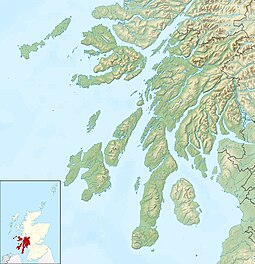| Scottish Gaelic name | Gunnaigh |
|---|---|
| Old Norse name | Gunni-øy |
| Meaning of name | "Gunni's island" |
| Location | |
 | |
| OS grid reference | NM100513 |
| Coordinates | 56°34′N 6°43′W / 56.56°N 6.72°W / 56.56; -6.72 |
| Physical geography | |
| Island group | Mull |
| Area | 69 ha (1⁄4 sq mi) |
| Area rank | 176 |
| Highest elevation | 35 m (115 ft) |
| Administration | |
| Council area | Argyll and Bute |
| Country | Scotland |
| Sovereign state | United Kingdom |
| Demographics | |
| Population | 0 |
| Population rank | 0 |
| References | |
Gunna (Gaelic: Gunnaigh) is an island in the Inner Hebrides of Scotland.
Geography and geology
Gunna lies between Coll and Tiree, closer to Coll. It is 69 hectares (1⁄4 square mile) in area and 35 metres (115 feet) at its highest point. Nowhere is it wider than 500 metres (550 yards). It has no permanent inhabitants; the only house is used as a holiday residence by its owner, Marcus de Ferranti.
It is surrounded by various smaller islands including Eilean Frachlan (just off the north coast), Eilean nan Gamhna off the south coast, Soy Gunna to the north east, and Eilean Bhoramull, which is nearer Coll. It is surrounded by many rocks, especially in Gunna Sound (Scottish Gaelic: Am Bun Dubh), between it and Tiree.
According to Haswell-Smith, the island has a: "bedrock of paragneiss schist with a light sandy soil. Metasediments in the west grade into undifferentiated gneiss in the east".
Etymology and history
"Gunni" is a Norse forename, and Haswell-Smith suggests that Gunni-øy means "island of Gunni the Dane" (although it is not recorded for which Gunni the island was named) or conceivably that the modern name is from Eilean nan Gamhna, Gaelic for "island of the stirks". Mac an Tàilleir suggests that the Norse means "Gunnar (hard R)'s island".
It was possibly an anchorite/culdee's island at some point – beside the old well, there is Port na Cille, which means Port of the Monk's Cell. Uamh Mòr, (big cave) on the north coast, could well be where the hermit sheltered.
According to Mac an Tàilleir Gunna is mentioned in the lines of a song, "Farewell beyond Gunna to Mull of the great mountains".
Wildlife
Gunna supports a wide range of sea birds, as well as geese, and shelducks. Grey seals also breed there.
It is currently used for grazing from Coll.
Gunna in fiction
Sandy Duncanson, the villain of Neil Munro's novel The New Road, comes from here, one chapter is titled "The Man from Gunna". It is suggested that this symbolises his ambiguous nature, since Tiree was "one of Mac Cailean Mór's loyal islands", and Coll was wild country.
See also
References
- ^ Area and population ranks: there are c. 300 islands over 20 ha in extent and 93 permanently inhabited islands were listed in the 2011 census.
- National Records of Scotland (15 August 2013). "Appendix 2: Population and households on Scotland's Inhabited Islands" (PDF). Statistical Bulletin: 2011 Census: First Results on Population and Household Estimates for Scotland Release 1C (Part Two) (PDF) (Report). SG/2013/126. Retrieved 14 August 2020.
- ^ Haswell-Smith, Hamish (2004). The Scottish Islands. Edinburgh: Canongate. pp. 115–16. ISBN 978-1-84195-454-7.
- Ordnance Survey. OS Maps Online (Map). 1:25,000. Leisure.
- "The Herald". Retrieved 7 November 2019.
- "Rannsaich/translation search". UHI. Retrieved 6 January 2008.
- ^ Mac an Tàilleir, Iain (2003) Ainmean-àite/Placenames. (pdf) Pàrlamaid na h-Alba. Retrieved 26 August 2012.
External links
56°34′N 6°43′W / 56.567°N 6.717°W / 56.567; -6.717
| Argyll Islands | |
|---|---|
| Islay | |
| West of Kintyre | |
| Knapdale and Loch Craignish | |
| Slate Islands | |
| Firth of Lorn and Loch Linnhe | |
| Mull | |
| Treshnish Isles | |
| Coll and Tiree | |
| Firth of Clyde | |
| Unknown | |
